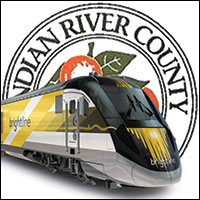 County: No money for railroad overpasses
County: No money for railroad overpasses
STORY BY RAY MCNULTY
Most of the county’s population resides west of the railroad tracks, and both of its local hospitals are located east of the tracks. So if Brightline’s passenger trains begin hurtling through the county 32 times per day – joined by more lengthy freights – a couple of years from now, what will ambulances do?
Most times, they’ll be forced to idle at the crossings, because county administrator Jason Brown says building overpasses to allow vehicular traffic to continue to flow over the tracks would be “very expensive” and there’s no money budgeted for such projects.
Phil Matson, staff director of the county’s Metropolitan Planning Organization, said cost estimates approached $30 million when local officials explored building overpasses at two crossings in the early 1990s.
At that time, however, officials decided the potential benefits weren’t worth the expense, Matson said, given how infrequently freight trains blocked emergency vehicles from crossing the tracks.
The price tag would be much higher now – so high that Brown said an overpass probably won’t be built unless Brightline builds it, which isn’t likely to happen.
“If Brightline wants to pay for improvements like that, it certainly would be both helpful and welcome,” Brown said. “But we’re not going to use tax dollars to do it.”
Cost, however, is only one obstacle.
Brown said overpasses often have adverse impacts – economically as well as socially and aesthetically – on adjacent areas, especially when the bridges are near busy roadways that require entrance and exits ramps.
“Living near an overpass or having a business there is, in many cases, not pleasant,” Brown said. “And there are issues with building one in an already-disadvantaged area, which could be the case here, depending on where you put it.
“You might be solving a problem in one area, but you’re making problems worse in another, which you don’t want to do.”
Twenty-five years ago, county officials studied the possibility of building overpasses over the tracks – and Old Dixie Highway – at 41st Street and State Road 512 to allow hospital-bound ambulances to avoid delays caused by freight trains.
The plan was eventually abandoned because of the costs, the intrusive impact on the adjacent areas and unexpected decreases in freight traffic.
Talk of overpasses disappeared until 2015, when the advent of All Aboard Florida, which gave birth to Brightline, prompted the MPO to resurrect the 1990s study.
“When All Aboard Florida became an issue and we began discussing our options, I mentioned that we had studied this before,” Matson said. “But that was almost three years ago, and there were too many unknowns.”
Now, though, Brightline is up and running in South Florida.
Four people already have been struck and killed by Brightline trains, just on the route between West Palm Beach and Fort Lauderdale, but the company continues to move forward with its plans to connect Miami with Orlando.
Members of Congress recently challenged Brightline’s government subsidized financing scheme for its Phase 2 expansion, but if the company ends up securing the Private Activity Bond allocations it seeks, high-speed trains could be zipping through Indian River County in a few years.
If that happens, construction of additional tracks along the Florida East Coast Railway route is expected to bring increased freight traffic, too.








